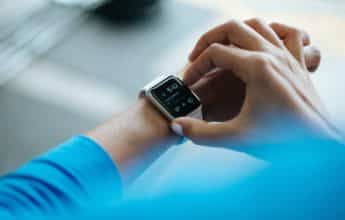Did you know that in 2021 there were more than 10 billion active Internet of Things (IoT) devices around the world? Furthermore, that number is expected to grow beyond 25.4 billion active devices by 2030! With so many devices falling under the umbrella of IoT, it can be difficult to fully understand what it is. In short, the IoT describes the growing network of devices that can collect, analyze, and exchange data in real-time with the aid of embedded sensors. To help clarify this immense subject further, we’ve compiled a list of 10 real-world IoT examples used across industries in 2022.
IoT Examples for 2022
Wearables
Wearable technology is a general term that refers to an extremely wide range of electronic devices. This broad category includes smartwatches, rings, glasses, shoes and clothing equipped with sensors, a plethora of accessories, and even technology tattooed on the skin or implanted into the body.
Not only are these devices likely the most recognizable examples of IoT devices, their demand has recently exploded. Now, many big names companies – including Samsung, Google, and Apple – have invested heavily in developing wearables. Devices like these use a combination of software and sensors to collect information about the user.
While wearables are used for many purposes, the most common are health, fitness, and entertainment.
Vehicles
Other commonly recognized IoT examples include connected cars and driverless vehicles. Connected cars use fast transmissions to improve driver response time through better and more robust vehicle communication. These vehicles use a unified connectivity platform called Cellular Vehicle-to-Everything (CV2X). This network is divided into four categories; Vehicle-to-Network (V2N), Vehicle-to-Infrastructure (V2I), Vehicle-to-Vehicle (V2V), and Vehicle-to-Pedestrians (V2P). Connected cars use this network, onboard sensors, and internet connectivity to optimize their operation and maintenance, as well as passenger comfort.
Additionally, autonomous, driverless vehicles also utilize the IoT. These vehicles use the power of IoT connectivity to update their driving algorithm based on driver data. In order to take on all the driving functions, autonomous vehicles need a constant flow of data collection and processing. This data includes variables like traffic conditions, the path taken, how to effectively navigate around an obstacle, and so on. All this data is shared wirelessly to the IoT system.
Smart Appliances
Another of the most common and well-known IoT examples is the smart home appliance. This is a broad area that includes a wide range of appliances, including smart refrigerators and thermostats. Smart appliances help save users time by granting control over the internet. Devices such as these aim to help you schedule, monitor, and improve your daily life. In fact, with smart appliances integrated into the home, you can now play an active role in every aspect of your home – whether you’re sitting in your living room, or half a world away.
Connected Healthcare
The next of our IoT examples is the Connected Healthcare System. The idea here is to connect healthcare systems and smart medical devices to aid in ones well-being. Combined with these smart medical devices, the Internet of Medical Things (IoMT) can provide powerful, high-quality medical services. This system supports and monitors critical data – data that can help make more informed clinical decisions.
The power of IoMT devices is that they monitor patients remotely. Smart devices, including wearables, can report events, like asthma or anxiety attacks, and emergencies, like heart failure. One example of a health wearable is a Continuous Glucose Monitoring system. Systems like these utilize a tiny glucose sensor, safely placed under the skin, to record data. This information is then relayed to the monitoring device – usually a smartphone – via radio transmission.
Barcode Readers
Modern, IoT empowered smart barcode readers have become a powerful tool for inventory management. These readers support an AI-based digital signal processing, and feature cloud data connections. Such devices make managing any inventory easier, and enhance the operations of logistics, warehousing, retail, and more.
What’s more, IoT barcode readers can also be used by customers as a part of their shopping experience. A shopping cart integrated with an IoT barcode reader utilized its AI-based sensors to detect products in the cart. This saves time at the checkout, creates a better customer experience, and tracks inventory accurately.
Supply Chain Management
Due to recent global events, the supply chain has become a major topic of concern and discussion. However, IoT devices have already begun revolutionizing supply chain management by making it much easier to know exactly where and how goods are stored, and when to expected their arrive at a specific destination. Smart supply chain management is constantly improving its predictions through smart routing and continuously updating algorithms.
IoT devices attached to packages offer immediate “after-incident” facts utilizing RFID and GPS. This allows for monitoring of a packages’ speed of movement and offers improved predictions regarding how goods will travel through the supply chain. IoT devices can also track other important parameters, such as humidity, temperature, exposure to atmosphere, light intensity, and more. What’s more, these devices can trigger other administrative tasks, such as supplier payments or further shipping. All this information allows for more informed supply chain decisions.
Industrial IoT
The Industrial Internet of Things (IIoT) involves all the computers, individuals, and devices that allow for intelligent industrial operations by utilizing advanced data collection and analysis. This often results in business outcomes so meaningful, they’re transformative. The IIot has broad reach beyond the consumer and enterprise IoT market. In fact, the automotive industry, agricultural industry, and oil and gas industries each utilize IIoT applications in their own ways.
The IIot takes all of the advantages of the IoT and elevates them. This is most easily seen in industries where the stakes are high, and human error can be disastrous. In fact, in situations involving significant industrial hazards, IIoT can reduce human employees’ exposure to unsafe environments.
Agriculture
Our next IoT examples is related to smart agriculture. With a growing population, farmers today face many problems, but smart IoT devices are now available to help ease their burdens. Smart agriculture utilizes IoT devices to enhance many farm related activities. For example, devices monitor soil moisture levels, as well as soil nutrients, determine when the best time to harvest is, and can create fertilizer recommendations based on real-time soil conditions.
A few other real-world examples of IIoT for agriculture include:
- Silo Stock – Sensors placed in silos can detect weight, temperature, and humidity, as well as warn of leaks.
- Greenhouse Automation – Greenhouse sensors provide real-time information on greenhouse conditions and can alter them based on optimal setting.s
- Environmental & Weather Data – Smart IoT devices detect and report on real-time conditions.
Smart Cities
Some cities have begun actively consolidating IoT deployment across as many aspects of city management as they can. This holistic view is turning them into smart cities. This integration often includes a connected traffic management system, as well as city-run smart buildings that utilize a vast array of IoT devices and appliances. What’s more, smart cities may also incorporate private smart buildings, and may tie into smart grids to monitor an even larger IoT environment. This, in turn, provides an incredibly robust, real-time views of each significant element impacting any given jurisdiction.
Although the concept of the smart city is much more ambitious than smaller IoT deployments, the objective remains the same: to collect and analyze real-time data and provide insights for better decision making and more efficient, effective, and safer communities.
Smart Grids
As with most of our IoT examples, the concept of the electrical grid is something most people are familiar with: the means by which power is supplied to communities. A smart grid differs from this concept in one important way – the flow of data is two-way thanks to digital communications technology.
A smart grid relies on a connection with all the utility’s assets, such as substations and meters. This interconnectedness allows for constant monitoring of the demand and supply of electricity across the grid. That means the smart grid can detect, act, and react to a range of changes across multiple issues. Not only does this allow for more efficient use of energy, it also provides better access to energy across the entire grid.
Closing Thoughts
IoT is already transforming many industries, and the pace of change is only accelerating. Advancements in technology will push consumer desire to incorporate more IoT devices into their everyday lives. What’s more, the advantages for enterprises can be found across every vertical and in a wide range of organizations.
In fact, regardless of industry, IoT deployment typically includes ROI such as:
- Lower operational costs;
- Improved productivity;
- Enhanced output;
- Improved safety;
- Increased security;
- Better quality control;
- Strengthened understanding of real-world activities.
Capitalizing on the opportunities the IoT offers requires necessary skill and expertise to set you apart from the crowd.
Keep Reading:
NFC: the Technology Behind Tap-and-Go Communication







